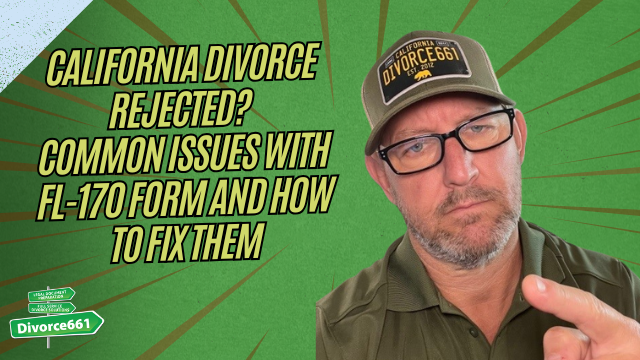What Happens If Your Spouse Doesn’t Respond to Divorce Papers in LA? — A Practical Guide from Divorce661
I’m Tim Blankenship of Divorce661. If you filed for divorce in Los Angeles County and your spouse hasn’t responded, you’re not stuck. In this article I’ll walk you through what happens next, the legal steps you can take, and how a default divorce works so you can move forward with your life.
Quick overview: Can you finish a divorce if your spouse is silent?
Yes. If your spouse is served and fails to respond within the required time, California law allows you to proceed without their participation. You don’t have to wait around indefinitely — you can file a Request to Enter Default and take control of the process.
The 30-day rule in Los Angeles County
Once your spouse is properly served with divorce papers, they have 30 days to file a response. If they don’t respond in that window, the court considers them in default and you become eligible to pursue a default judgment.
Step-by-step: How the default process works
- Serve the divorce papers — Proper service is required to start the timeline.
- Wait 30 days — This is the statutory response period.
- File a Request to Enter Default — This formally notifies the court that the other party did not respond.
- Prepare financial disclosures and proposed judgment — These documents explain the terms you’re asking the court to approve.
- Court review — The judge reviews your paperwork and, if everything is in order, signs the judgment without a hearing.
- Divorce finalized — Once the judgment is signed, your divorce is complete even though the other party never participated.
Filing a Request to Enter Default — what you need to know
Filing a Request to Enter Default isn’t just a formality — it’s the legal step that moves your case forward when the other side is silent. Accuracy in your filings is critical. Mistakes or missing information can delay approval.
Why accurate financial disclosures matter
Financial disclosures are the backbone of a default judgment. You must provide clear, accurate information about income, assets, debts, and any requests for spousal support, attorney fees, or property division. The court relies on these disclosures to determine whether the terms you propose are fair and legally sound.
- Include current income details and pay stubs where applicable.
- List all assets and debts with estimated values.
- Describe any requests for child or spousal support, custody terms, and attorney fees.
- Double-check forms for completeness before filing.
Drafting and submitting your default judgment
Your proposed judgment outlines every term you want the court to adopt: division of property, debts, support, custody (if applicable), and any other orders. Once submitted, the court reviews the package. If the paperwork is complete and the terms are legally acceptable, the judge can sign the judgment without requiring a hearing.
“You don’t have to wait indefinitely.”
A real client example
One client came to us after her spouse ignored every notice and refused to participate. We filed the Request to Enter Default, prepared her proposed judgment and necessary disclosures, and submitted everything to the court. The judgment was approved in a matter of weeks — no hearing, no drama, and the divorce was finalized.
Why working with professionals helps
There are several advantages to working with a team experienced in default divorces across L.A. County:
- We handle all forms, disclosures, and court filings remotely.
- Flat-fee pricing means no surprise costs.
- Experience reduces errors that cause delays.
- You get a faster, legally sound resolution even if the other party refuses to participate.
Next steps — if your spouse hasn’t responded
If your spouse didn’t respond within 30 days, consider filing a Request to Enter Default and preparing your proposed judgment and financial disclosures. If you want help, visit Divorce661.com to schedule a free consultation. We’ll review your situation, explain your options, and, if appropriate, handle the filings so you can move forward.
Final thoughts
Silence from your spouse doesn’t have to stall your life. A default divorce is a legitimate, efficient path to finalizing your separation when the other party won’t participate. With accurate disclosures and the right paperwork, the court can approve a judgment without a hearing and close your case.
If you’re ready to take the next step, reach out for a free consultation at Divorce661.com. We’re here to help you get through this quickly and correctly.










